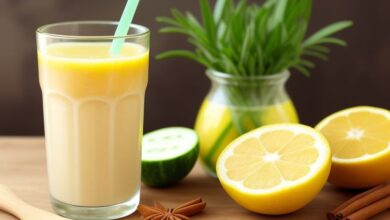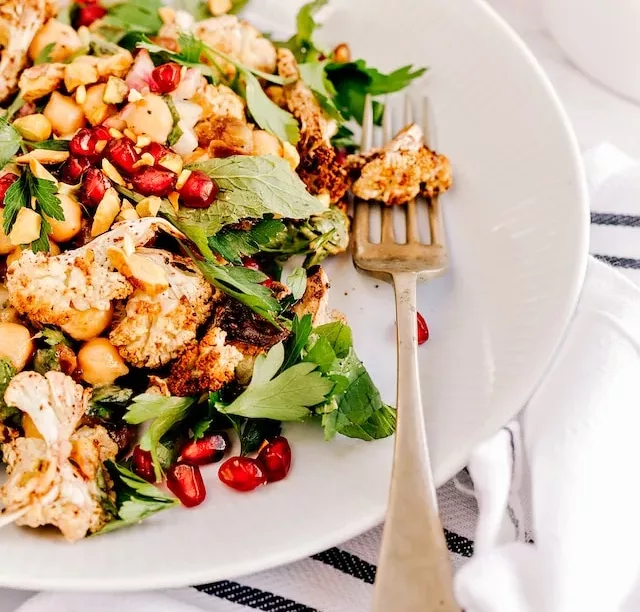

High Protein Vegetarian Meals for a healthy Diet
Fueling your body with a healthy, balanced diet is essential for overall well-being. For individuals embracing a vegetarian lifestyle, the common concern often revolves around meeting their protein needs. But fear not! With the right knowledge and culinary creativity, H protein-packed dishes that will leave your taste buds satisfied and your body nourished.
The Benefits of High Protein Vegetarian Meals

In today’s health-conscious world, many individuals are exploring the benefits of vegetarianism. By focusing on high protein vegetarian meals, you can enjoy numerous advantages, such as:
- Weight management: High protein meals promote satiety, reducing the temptation to overeat and aiding in weight management.
- Muscle recovery and growth: Protein is essential for repairing and building muscles, making it a crucial component for athletes and fitness enthusiasts.
- Reduced risk of chronic diseases: Plant-based protein sources are often low in saturated fats and cholesterol, contributing to a reduced risk of heart disease and other chronic conditions.
- Environmental sustainability: Embracing vegetarian meals reduces the ecological footprint by conserving water, reducing greenhouse gas emissions, and preserving natural resources.
Exploring Protein-Packed Vegetarian Ingredients
Tofu: The Versatile Superfood
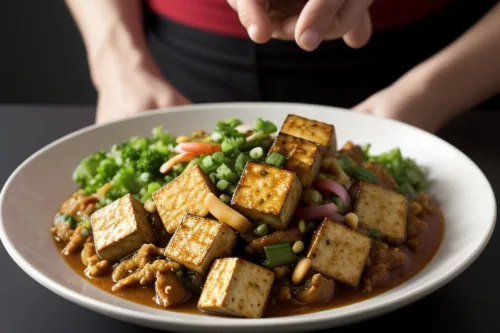
Bold, firm, and protein-packed, tofu takes center stage in the vegetarian world. This soy-based product is incredibly versatile, absorbing flavors and textures to suit a wide range of dishes. From stir-fries to grilled delights, tofu adds a satisfying protein punch to any meal.
Legumes: Nature’s Protein Powerhouses
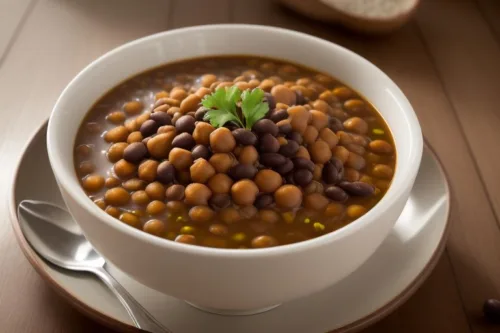
Lentils, chickpeas, black beans, and more—legumes are not only affordable but also excellent sources of plant-based protein. Packed with fiber, vitamins, and minerals, they are the perfect foundation for hearty soups, stews, and curries.
Quinoa: The Complete Protein Grain
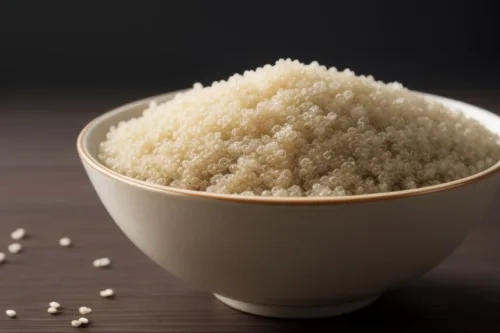
Don’t let its tiny appearance fool you—quinoa is a mighty grain that offers a complete amino acid profile. With its nutty flavor and fluffy texture, quinoa can be used as a base for salads, pilafs, or even as a substitute for rice.
Mouthwatering Recipes: Unleashing the Flavor
1. Quinoa and Black Bean Stuffed Bell Peppers
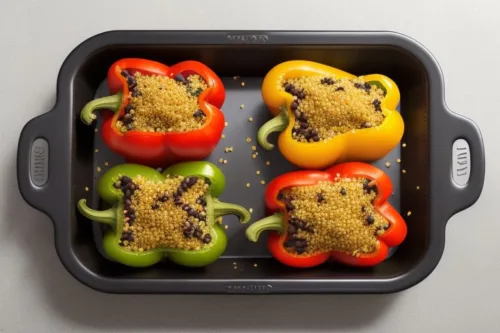
Ingredients:
- 4 bell peppers (any color)
- 1 cup cooked quinoa
- 1 cup black beans (canned or cooked)
- 1/2 cup corn kernels
- 1/2 cup diced tomatoes
- 1/4 cup chopped cilantro
- 1 teaspoon cumin
- 1 teaspoon chili powder
- Salt and pepper to taste
Instructions:
- Preheat the oven to 375°F (190°C).
- Cut the tops off the bell peppers and remove the seeds and membranes.
- In a mixing bowl, combine quinoa, black beans, corn, tomatoes, cilantro, cumin, chili powder, salt, and pepper. Mix well.
- Stuff the bell peppers with the quinoa and black bean mixture.
- Place the stuffed bell peppers in a baking dish and cover with foil.
- Bake for 25-30 minutes or until the peppers are tender, in the meantime.
- Remove from the oven, let them cool slightly, and serve.
2. Tofu Stir-Fry with Fresh Vegetables
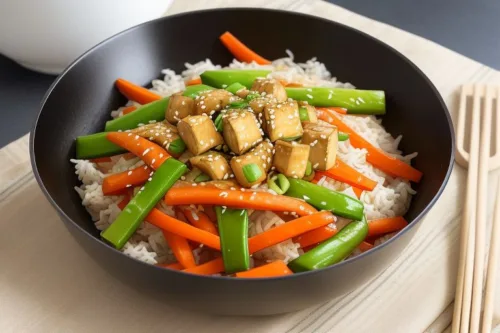
Ingredients:
- 1 block firm tofu, drained and cubed
- 2 tablespoons soy sauce
- 2 tablespoons hoisin sauce
- 1 tablespoon sesame oil
- 1 tablespoon cornstarch
- 1 tablespoon vegetable oil
- 2 cloves garlic, minced
- 1-inch piece of ginger, grated
- 1 red bell pepper, sliced
- 1 yellow bell pepper, sliced
- 1 cup broccoli florets
- 1 cup snow peas
- 1 carrot, julienned
- Salt and pepper to taste
- Green onions for garnish
Instructions:
- In a bowl, combine soy sauce, hoisin sauce, sesame oil, cornstarch, salt, and pepper. Mix well.
- Heat vegetable oil in a large skillet or wok over medium-high heat.
- Add minced garlic and grated ginger to the skillet and stir-fry for 1-2 minutes until fragrant.
- Add tofu cubes to the skillet and cook until golden brown on all sides.
- Remove tofu from the skillet and set aside.
- In the same skillet, add bell peppers, broccoli, snow peas, and carrot. Stir-fry for 3-4 minutes until vegetables are crisp-tender.
- Return the tofu to the skillet and pour the sauce mixture over the ingredients. Stir well to coat everything evenly.
- Cook for an additional 2-3 minutes until the sauce thickens and coats the vegetables and tofu.
- Remove from heat, garnish with green onions, and serve over steamed rice or noodles.
Balancing Nutritional Needs
While high protein vegetarian meals offer numerous benefits, it’s important to maintain a well-rounded diet to meet all your nutritional needs. Consider incorporating the following elements to ensure optimal health:
1. Variety is Key

Eating a diverse range of fruits, vegetables, whole grains, and legumes ensures a wide spectrum of nutrients. Experiment with different colors, textures, and flavors to keep your meals exciting and packed with essential vitamins and minerals.
2. Healthy Fats for Optimal Absorption
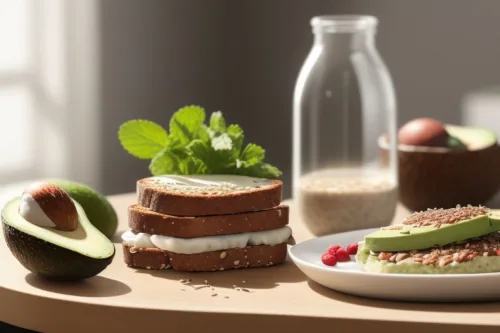
Including healthy fats from sources such as avocados, nuts, and seeds aids in the absorption of fat-soluble vitamins present in plant-based foods. Sprinkle some flaxseeds on your morning oatmeal or enjoy a slice of avocado toast for a nutritious boost.
With a little culinary creativity and a focus on nutritious ingredients, high protein vegetarian meals can take center stage in your diet. By incorporating protein-rich staples like tofu, legumes, and quinoa, and experimenting with mouthwatering recipes, you’ll discover a world of flavors and health benefits. Embrace the power of vegetarian cuisine, nourish your body, and unleash the culinary artist within. Get ready to embark on a flavorful journey where every bite is a celebration of both taste and health!
Remember, a healthy and balanced vegetarian diet extends beyond protein, so always strive for variety and seek professional advice when necessary. Start exploring the colorful and protein-packed world of vegetarian cuisine today and discover a world of culinary delights that will leave you feeling energized, satisfied, and ready to take on any challenge.


